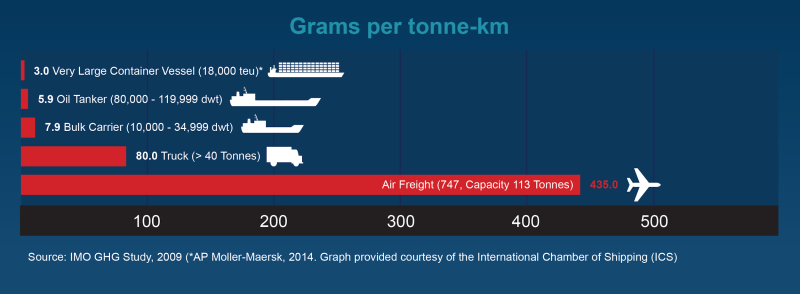6.1.3
International sea & air freighting
Product supply chains operate on an international basis. Long distance transportation for retail goods is overwhelmingly by sea freight, using high volume container ships as well as vehicle carriers into the UK from major ports including Calais and Rotterdam.
Air freighting volumes are limited in retail supply chains because of its relatively high cost. The two major uses of air freight for retail are for categories of fresh produce and cut flowers where speed is critical for product quality; and in niche segments where rapid responsiveness is a key feature of the service (such as fast fashion or high value technology, and next day guaranteed delivery).
Emissions profile
Sea freight is generally highly efficient under the ‘tonne kilometre’ metric, reported as 3gCO2e for fully-laden very large container vessels, to 8gCO2e for bulk carriers. However, given the volume of goods transported, the emissions from sea freight are significant. The World Wide Fund for Nature (WWF) estimates that international shipping accounted for 8MtCO2e of emissions attributable to the UK in 2015.[59] The Department for Business, Energy & Industrial Strategy reported a similar figure for emissions from UK international shipping – though their report notes that attribution of shipping emissions to individual countries is challenging, given international registrations and ports of call.
Air freighting is a carbon intensive activity. Comparative emissions are 435gCO2e per tonne km, which is more than 50 times as impactful as sea freight by bulk carrier. Sustainable Aviation estimates that freight-only flights amounted to 1MtCO2e in 2015, or 0.3% of the UK’s total footprint.[60] However, only 3% of the UK’s aviation industry's emissions originate from freight-only flights. 97% of emissions are from passenger flights, but approximately half of global air freight is carried in the hold of passenger aircraft – meaning that emissions should be split between passengers and goods.
Figure 6.1c: emissions factors (in grams per tonne-km) for freight modes, from International Chamber of Shipping
With very few exceptions, sea and air freight are reported as scope 3 emissions by retailers.
Routes to decarbonisation for sea & air freighting
In the short term, shorter supply chains and efficiency improvements, including fuel saving measures and supply chain optimisation, offer the best opportunity to shrink emissions. Long term, the shift will be out of fossil fuels – in air freight, to alternative jet fuels, and in shipping to possible alternatives such as hydrogen, ammonia or electric power.
[59] Keeping it Cool: How the UK Can End its Contribution to Climate Change (2018). WWF.
[60] Decarbonisation Road-Map: A Path to Net Zero (2020). Sustainable Aviation.
